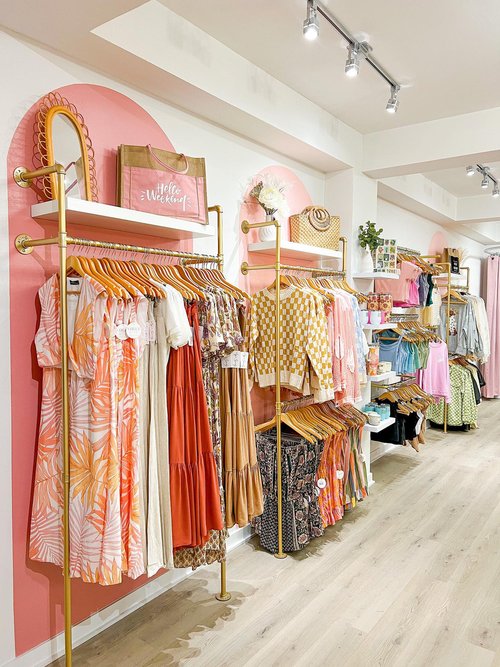Boost Your Closet with Spectacular Boutique Fashion Basics
Boost Your Closet with Spectacular Boutique Fashion Basics
Blog Article
Sustainable Fashion: Just How Eco-Friendly Clothing Is Shaping the Future of Design
As the fashion sector deals with raising scrutiny over its ecological impact, the increase of lasting fashion provides an appealing choice that aligns style with eco-friendly responsibility. boutique fashion. Exactly how does this activity genuinely affect the future trajectory of fashion, and what challenges lie ahead in its widespread adoption?
Innovative Lasting Materials
As the style industry grapples with its ecological effect, cutting-edge lasting products have actually emerged as an essential remedy for reducing environmental impacts. These materials not just reduce reliance on fossil gas however likewise lessen dangerous chemical usage and water consumption.
Along with plant-based materials, improvements in biofabrication have actually led to the growth of lab-grown fabrics. Mycelium leather, acquired from mushroom origins, offers a functional and biodegradable choice to pet natural leather. Its manufacturing causes substantially reduced carbon discharges and water use, making it a more sustainable choice for stylist seeking to align with environment-friendly practices.
Recycled products are likewise acquiring grip, with polyester made from recycled plastic containers representing a significant innovation. This innovation not just diverts plastic waste from seas and garbage dumps however additionally decreases power usage contrasted to producing virgin polyester. Together, these materials highlight the potential for an extra lasting apparel industry, leading the method for eco mindful design and production.
Eco-Conscious Manufacturing
Building on the developments in sustainable materials, the apparel industry is also re-evaluating its manufacturing processes to additionally reduce ecological influence. Key approaches include lessening water consumption, minimizing carbon discharges, and getting rid of unsafe chemicals. By adopting closed-loop systems, manufacturers intend to reuse water and energy efficiently, substantially reducing waste. The combination of renewable resource resources, such as solar and wind power, into production facilities further curtails reliance on nonrenewable fuel sources.
One more crucial aspect is the reduction of hazardous chemicals commonly used in dyeing and ending up textiles. Eco-conscious suppliers are changing in the direction of plant-based dyes and waterless dyeing modern technologies, which not only safeguard local environments but likewise boost worker safety. Innovations like digital printing decrease textile waste and energy usage, using a cleaner option to typical techniques.
With the innovation of blockchain modern technology, firms can currently offer in-depth insights right into their supply chains, guaranteeing ecologically pleasant and moral practices at each step. As the demand for eco-conscious items grows, makers are obliged to introduce, making certain that the future of fashion is both sustainable and stylish.
The Rise of Upcycling
Upcycling, a transformative practice in sustainable fashion, entails artistically repurposing thrown out products into new, top notch items. This ingenious technique not just minimizes waste but likewise decreases the demand for resources, thus reducing the ecological impact of garments manufacturing. By rebuilding and reimagining existing items, designers and style brand names are able to instill originality into their collections while advertising environmental obligation.

Moreover, the upcycling movement has encouraged independent designers and tiny organizations, that typically lead in development as a result of their dexterity and creative thinking. By exploiting on the bountiful accessibility of unused products, these entities add to a round economic climate, showing that style can be both sustainable and stylish. With upcycling, the industry takes substantial strides in the direction of a more responsible and mindful future.
Thrift Culture's Effect
The expanding second hand culture substantially improves the landscape of lasting fashion, emphasizing the importance of conscious intake. This social change urges consumers to welcome previously owned clothes, thus reducing the need for brand-new garment manufacturing and lessening environmental effect. Second hand shopping not just extends the lifecycle of garments yet also lowers the carbon impact associated with manufacturing, delivering, and dealing with garments.
An essential aspect of second hand culture is its democratization of fashion. By providing a wide variety of designs from different periods at budget friendly rates, second hand shops make style available to a wider target market. This ease of access cultivates a sense of uniqueness and imagination, as consumers mix and suit special items to curate customized closets without adding to the fast fashion cycle.
Moreover, second hand culture advertises circularity in fashion, aligning with the concepts of a circular economic situation. By recirculating garments, the cycle of waste is interrupted, and sources are preserved. This technique supports a change from a linear "take-make-dispose" model to an extra sustainable structure. As even more customers and designers embrace thrift society, the apparel industry is compelled to adapt, incorporating lasting techniques to meet the expanding need for eco-conscious alternatives.

Future Trends in vogue
Fashion's advancement is progressively formed by technical technologies and sustainability-driven efforts. One popular pattern is the increase of digital fashion, where virtual garments can be worn in enhanced truth environments, substantially minimizing fabric waste.
Furthermore, the integration of blockchain modern technology supplies new possibilities in transparency and traceability, permitting customers to validate the sustainability qualifications of their clothing. boutique fashion. This ensures liability in supply chains and promotes moral sourcing practices. 3D printing is yet another development that assures to reinvent making procedures by making it possible for on-demand production, consequently minimizing excess stock read this article and waste
In addition, the development of bio-fabricated materials, such as lab-grown leather and plant-based fabrics, presents lasting alternatives to standard materials. These advancements reduce dependence on pet items and resource-intensive crops. As these innovations mature, they are poised to transform the style landscape, combining design with sustainability. The future of style, consequently, hinges on a seamless mix of technology, advancement, and eco-friendly duty.
Final Thought
The change of the style sector with sustainable techniques indicates an essential change in the direction of environmental liability. This evolution not only aligns style with ecological sustainability but additionally establishes a criterion for future fads concentrated on responsibility and advancement.
As the fashion sector deals with raising examination over its environmental impact, the rise of lasting fashion uses an appealing option that straightens design with environmental responsibility.As Learn More Here the fashion market grapples with its ecological effect, innovative sustainable products have emerged as a vital option for decreasing environmental footprints. With each other, these materials underscore the capacity for a more lasting fashion sector, leading the means for eco conscious layout and manufacturing.
Building on the innovations in sustainable materials, the fashion industry is likewise re-evaluating its production processes why not find out more to additionally lower environmental impact. boutique fashion.Upcycling, a transformative method in lasting style, entails artistically repurposing thrown out products into brand-new, top notch products
Report this page